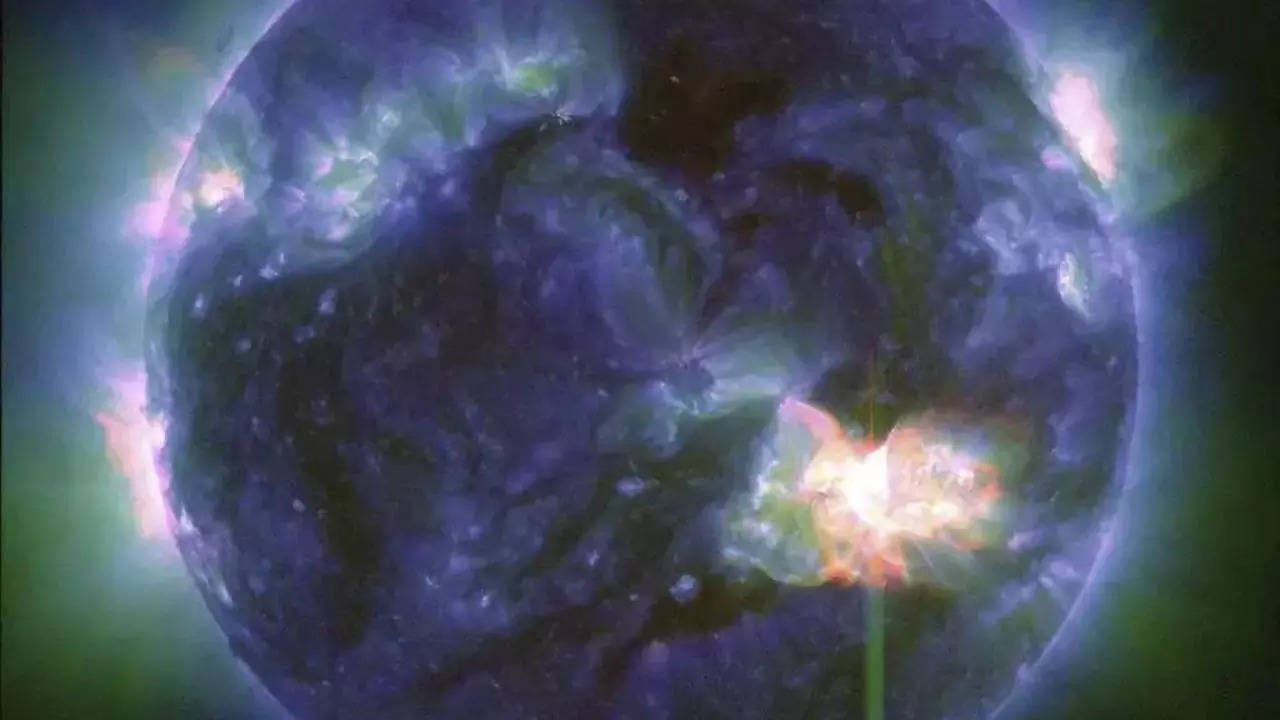[ad_1]
The first of several coronal mass ejections (CMEs) – expulsions of plasma and magnetic fields from the Sun came at 1600 GMT, according to the US National Oceanic and Atmospheric Administration (NOAA)”s Space Weather Prediction Center.
It was later upgraded to an “extreme’ geomagnetic storm — the first since the so-called “Halloween Storms’ of October 2003 caused blackouts in Sweden and damaged power infrastructure in South Africa. More Coronal Mass Ejections are expected to impact the planet in the upcoming days.
Social media was filled with individuals sharing images of auroras from northern Europe and Australasia.
“We’ve just woken the kids to go watch the Northern Lights in the back garden! Clearly visible with the naked eye,” Iain Mansfield was quoted as saying.
“Absolutely biblical skies in Tasmania at 4am this morning. I’m leaving today and knew I could not pass up this opportunity,” photographer Sean O’ Riordan posted on X alongside a photo.
Authorities informed satellite operators, airlines, and the power grid to be cautious due to possible disturbances from alterations in Earth’s magnetic field.
Solar flares travel at the speed of light and reach Earth in around eight minutes, while CMEs travel at a slower pace, currently averaging 800 kilometers (500 miles) per second.
They originated from a large cluster of sunspots that is 17 times wider than Earth. The Sun is nearing the peak of an 11-year cycle that results in increased activity.
Mathew Owens, who is a professor of space physics at the University of Reading was quoted by AFP as saying that the impacts would mainly be experienced across the northern and southern latitudes of the planet, with the extent of their reach depending on the final strength of the storm.
“Go outside tonight and look would be my advice because if you see the aurora, it’s quite a spectacular thing,” he added. People with eclipse glasses can also observe the sunspot cluster during the day.
Officials said that in the United States, the display of celestial lights can be seen in locations like Northern California and Alabama.
Brent Gordon from NOAA suggested that people should attempt to take photos of the night sky using their phone cameras, even if they are unable to see auroras with their naked eyes.
“Just go out your back door and take a picture with the newer cell phones and you’d be amazed at what you see in that picture versus what you see with your eyes.”
Fluctuating magnetic fields that come with geomagnetic storms create currents in long wires such as power lines, which may result in power outages. Additionally, extended pipelines may get electrified, causing issues in engineering.
Spacecraft are also vulnerable to high levels of radiation, but Earth’s atmosphere shields it from reaching the planet.
NASA has a dedicated team that is investigating astronaut safety. They can request astronauts on the International Space Station to relocate to areas within the outpost that provide better shielding.
Pigeons and other species with internal biological compasses may also be impacted. Pigeon handlers have noted a reduction in birds coming home during geomagnetic storms, according to NASA’s Jet Propulsion Laboratory.
Officials mentioned that individuals should be prepared for power outages by having essential items like flashlights, batteries, and radios easily accessible.
The most powerful geomagnetic storm in recorded history, known as the Carrington Event, occurred in September 1859, named after British astronomer Richard Carrington.
( with input from agency)
function loadGtagEvents(isGoogleCampaignActive) { if (!isGoogleCampaignActive) { return; } var id = document.getElementById('toi-plus-google-campaign'); if (id) { return; } (function(f, b, e, v, n, t, s) { t = b.createElement(e); t.async = !0; t.defer = !0; t.src = v; t.id = 'toi-plus-google-campaign'; s = b.getElementsByTagName(e)[0]; s.parentNode.insertBefore(t, s); })(f, b, e, 'https://www.googletagmanager.com/gtag/js?id=AW-877820074', n, t, s); };
function loadSurvicateJs(allowedSurvicateSections = []){ const section = window.location.pathname.split('/')[1] const isHomePageAllowed = window.location.pathname === '/' && allowedSurvicateSections.includes('homepage')
if(allowedSurvicateSections.includes(section) || isHomePageAllowed){ (function(w) { var s = document.createElement('script'); s.src="https://survey.survicate.com/workspaces/0be6ae9845d14a7c8ff08a7a00bd9b21/web_surveys.js"; s.async = true; var e = document.getElementsByTagName('script')[0]; e.parentNode.insertBefore(s, e); })(window); }
}
window.TimesApps = window.TimesApps || {};
var TimesApps = window.TimesApps;
TimesApps.toiPlusEvents = function(config) {
var isConfigAvailable = "toiplus_site_settings" in f && "isFBCampaignActive" in f.toiplus_site_settings && "isGoogleCampaignActive" in f.toiplus_site_settings;
var isPrimeUser = window.isPrime;
if (isConfigAvailable && !isPrimeUser) {
loadGtagEvents(f.toiplus_site_settings.isGoogleCampaignActive);
loadFBEvents(f.toiplus_site_settings.isFBCampaignActive);
loadSurvicateJs(f.toiplus_site_settings.allowedSurvicateSections);
} else {
var JarvisUrl="https://vsp1jarvispvt.indiatimes.com/v1/feeds/toi_plus/site_settings/643526e21443833f0c454615?db_env=published";
window.getFromClient(JarvisUrl, function(config){
if (config) {
loadGtagEvents(config?.isGoogleCampaignActive);
loadFBEvents(config?.isFBCampaignActive);
loadSurvicateJs(config?.allowedSurvicateSections);
}
})
}
};
})(
window,
document,
'script',
);
[ad_2]
Source link





